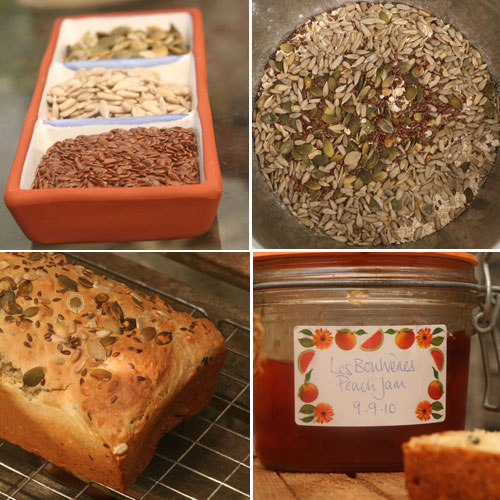With two cooks in the house, sometimes my mental inventory of stores doesn’t tie in with what is (or, more often, is not) in the cupboard. I’ll often be half-way through baking a cake and I’ll reach for the eggs only to find that my beloved must have made a giant omelette for breakfast because the dozen or so that were there yesterday have vanished.
 |
| White Soda Bread with Seeds - merely a delivery device for peach jam |
Today, I had a hankering for brown soda bread to go with my friend Penny’s incredible Peach Jam. There were a few obstacles in my way, namely no brown flour, and no oatmeal – the two main constituents of my brown soda bread recipe. I could have sworn there was some there last time I looked... hmmmmm.
This white soda bread was a total experiment. I added the seeds to make it seem half-healthy.
 |
| A quick and easy bread for when you're in a jam... |
Soda bread is normally cooked on a baking sheet. This is quite a wet mixture so I’ve used a 2LB loaf tin.
For one 2LB loaf you will need...
... to pre-heat your oven to 200°C
... to pre-heat your oven to 200°C
1 teaspoon olive/sunflower oil for the baking tin
Dry ingredients
500g plain flour
1 teaspoon bicarbonate of soda
1 teaspoon salt
125g mixed seeds (I used 50g pumpkin, and 25g each of brown linseed, sesame, and sunflower)
1 tablespoon runny honey
400mls buttermilk
1 Rub a 2LB loaf tin with the olive/sunflower oil.
2 Place the flour, bicarbonate of soda, salt and seeds in a mixing bowl, keeping back about a tablespoon of the mixed seeds. Stir the runny honey to the buttermilk, and add to the dry ingredients mixing just until no dry flour remains.
3 Transfer to the prepared baking tin and level the surface before scattering with the tablespoon of seeds you reserved. Place in the pre-heated oven and set your timer for 10 minutes. After 10 minutes has elapsed, lower the heat to 180°C and continue baking for a further 15 minutes.
4 Take the loaf from the oven and remove the tin. A cooked loaf will sound hollow when tapped on the base.
5 Leave to cool completely on a wire rack before slicing.
 |
Always seek out the seed of triumph in every adversity ~ Og Mandino ... like making bread out of nothing when your other half has raided the stores ~ me |
As I’m writing this, my beloved has started cooking his demon chicken curry. I wonder when he’ll discover that I’ve used the last of the yoghurt... and the cardamom... and the chillies... J
Pin It



















